Pergamon
Q18986Pergamon (Greek: τὸ Πέργαμον; Latin Pergamum): city in Teuthrania, famous for a sanctuary of Asclepius, important during the Hellenistic age under the Attalid dynasty. Modern Bergama.
Origin
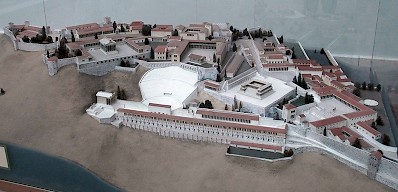
There are several stories about the foundation of Pergamon. The town was, reportedly, named after Pergamus, the son of Andromache (the widow of Hector of Troy) and Neoptolemus (the son of Achilles). The one who founded the city and named it after Pergamus, was one of the heroes of the Trojan War: Telephus, who was a son of Heracles. In other words: the Pergamenes believed that their town had been founded immediately after the Trojan War and their rulers said they were descendants of Heracles and his divine father, the Greek supreme god Zeus.
Claims like these could only be made by powerful cities - and Pergamon was a powerful city. Situated on a steep rock, it dominated Teuthrania, i.e., the fertile plain of the river Caicus (modern Bakırçay), which emptied itself in the Aegean Sea some thirty kilometers west of Pergamon. Like Athens and Rome, Pergamon was close enough to the sea to benefit from interregional trade, but far enough to be protected against pirate raids. A road connected Pergamon to the cities of the Hellespont in the north, and to the Greek cities of Smyrna, Ephesus, and Miletus in the south. Pergamon was destined to become a mighty city.
Early History
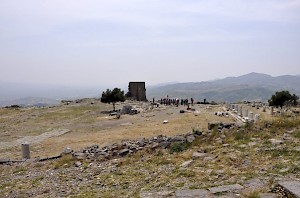
In spite of the Pergamenes' claim that their city was founded shortly after the Trojan War, the oldest archaeological finds date back to the seventh century: houses on the southern slope. The Greek historian Xenophon (c.430-c.354) mentions that in the age of the Persian Wars, several Greeks who had fought with the invaders, had been awarded land and small towns in this part of Asia, and they appear to have lived in Pergamon.note Wealthy, pro-Persian Greek landlords like these certainly fit our picture of Achaemenid Asia. It is also possible that they built the temple of Demeter, which was erected on the southern slope in the fifth century.
From the second half of the fourth century are the temple of Athena Nikephoros, the victory-bringing Athena, on the citadel, and the sanctuary of Asclepius, the healing god. This temple was at some distance, about two kilometers, to the southwest of the citadel, and was to become one of the major cult centers of the ancient world. According to Pausanias, the god was introduced to Pergamon by a man named Archias, who had in the original sanctuary in Epidauros been cured after a hunting accident.note
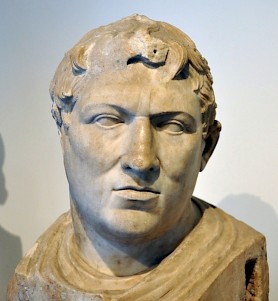
The town was still quite obscure when, in about 325 BCE a Persian lady settled in Pergamon: Barsine, daughter of a local Persian potentate named Artabazus, former mistress of Alexander the Great, and mother of his first son, Heracles. Suddenly, control of Pergamon and Alexander's son was of strategic importance. The town got noticed. There must have been a garrison on the citadel, which must have remained there even after the death of Barsine and Heracles in 309. It was ready when one of the successors of Alexander, Lysimachus, chose Pergamon as the place where he would store his treasure (301 BCE). The treasurer was a eunuch called Philetaerus.
Philetaerus: Raise to Power
About Philetaerus' first steps not much is known, but it is likely that he had already strengthened the walls of the citadel and felt sufficiently secure to embark upon a policy of his own, siding with Seleucus I Nicator, the "king of Asia", against his master Lysimachus.note After the Battle of Corupedium (281), in which Lysimachus fell, Seleucus held Philetaerus in high esteem. The sympathy was mutual: when Seleucus was assassinated (by Ptolemy Keraunos), Philetaerus paid for the dead body and sent it to Seleucia, where Seleucus' son Antiochus I Soter could arrange the funeral.note
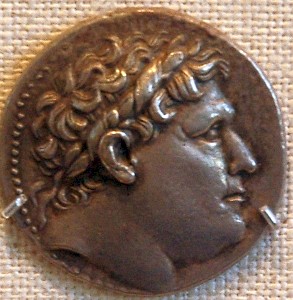
For almost twenty years, Philetaerus could rule more or less independently, and laid out a gridiron street plan between the citadel and the temple of Demeter, which was expanded. A bathhouse was added, while in the plain, the temple of Asclepius was rebuilt, using marble. Nothing of this was really spectacular: a garrison town was becoming a real city. An inscription, however, tells another story. Because of the crisis after the deaths of Lysimachus and Seleucus, northern tribes had felt confident enough to invade Macedonia; some of these Galatians had proceeded to Greece and had sacked Delphi in 279. Others moved to the east and crossed the Hellespont. One of the towns over there, Cyzicus, looked for support and received it from Philetaerus (278).note Pergamon had embarked upon a foreign policy of its own.
Eumenes I: Expansion
In 263, Philetaerus was succeeded by Eumenes, a son of his brother. That a dynasty had been founded, is shown by the fact that Eumenes minted coins with the portrait of his uncle. The dynasty was to become known as the Attalids.
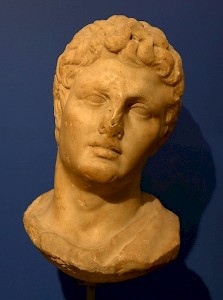
Still, these were difficult years. King Antiochus I Soter of the Seleucid Empire had been a friendly overlord, who had allowed Philetaerus considerable independence. After all, he had enabled the funeral of Seleucus. However, that was a personal favor to a special man. Antiochus was not willing to grant this same freedom to Eumenes, and war broke out. In 262, the armies met near Sardes, where, Eumenes defeated his superior, who was to die one year later.note
Eumenes remained friendly to Antiochus' son and successor Antiochus II Theos, but took his precautions by allying himself to Ptolemy II Philadelphus, the king of Egypt, in the Second Syrian War (260-253). While Antiochus and Ptolemy fought the main battles, Eumenes benefited by expanding his zone of influence to the south, along the coast, without interfering so much with Seleucid interests that it became a cause for renewed war.
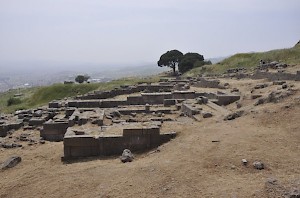
The Galatians had by now reached central Anatolia. Eumenes, who was increasingly interested in the Upper Caicus Valley and might easily have come into conflict with these tribes, paid them off and managed to stabilize his realm. He also invited philosophers and artists to come to his city, which soon became an important center for Middle Platonism.
Eumenes died in 241. Just like he had been chosen by his uncle Philetaerus, he chose the son of his own brother as successor: Attalus I Soter, who was to achieve the full independence of Pergamon and accepted the royal title. His first regnal act, however, was to award heroic honors to Eumenes. On the citadel, heroön was built: the sanctuary for Pergamene ruler cult, first for the Attalids and later for the Roman emperors too.